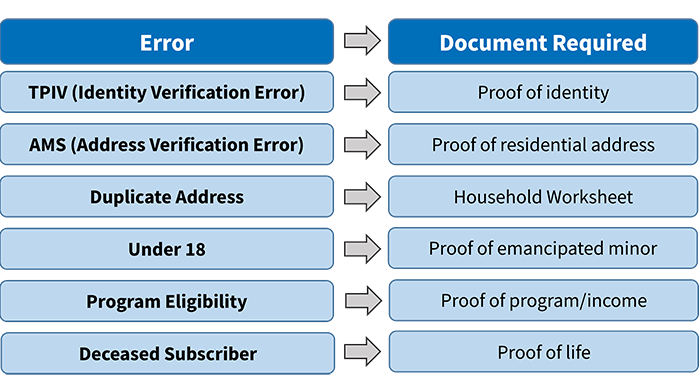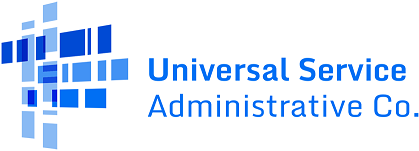Resolve Application Errors
An application may result in an error that requires the consumer to submit additional documentation to the Lifeline Support Center for manual review.
The following chart displays the errors that require additional information.
If a consumer receives one or more of the errors listed below, they may submit the information under “Documentation Required” via mail to the Lifeline Support Center or online using the service provider or consumer portal. Consumers should always submit copies of their documentation, never originals. If a consumer is submitting documentation via mail, they must include the completed cover sheet.

Eligibility Documentation
When eligibility cannot be verified through any of the National Verifier’s automated data sources, the consumer can submit eligibility documentation to the Lifeline Support Center, which will initiate a manual review process to determine if the consumer is eligible.
The documentation requested will vary by program or income information available.
Program Participation
To prove participation in a Lifeline qualifying program, consumers must submit a document that, at a minimum, includes:
- The consumer’s name, or the name of the consumer’s benefit qualifying person (BQP);
- The name of the Lifeline-qualifying program, such as SNAP;
- The government or Tribal program administrator or the managed care organization (MCO) that issued the document; and
- An issue date within the last 12 months or a future expiration date that aligns with the benefit period.
Household Income
To prove a consumer’s household income is 135% or less than the federal poverty guidelines, consumers must submit one or more of the following documents*:
- The prior year’s state, federal, or Tribal tax return
- Current income statement from an employer or paycheck stub
- A Social Security statement of benefits
- A Veterans Administration statement of benefits
- A retirement/pension statement of benefits
- Unemployment/workers’ compensation statement of benefit
- Federal or Tribal notice letter of participation in General Assistance
- Divorce decree, child support award, or other official document containing income information
*If the consumer presents documentation of income that does not cover a full year, such as current pay stubs, the consumer must present the same type of documentation covering three consecutive months within the previous 12 months.
Identity Verification
When a Third-Party Identity Verification (TPIV) validation is not verified through any of the National Verifier’s automated data sources, the consumer can submit documentation to resolve the error(s) related to their identity.
Below are various types of TPIV errors that a consumer may receive and documentation needed to resolve the errors.
Social Security Number, Date of Birth (DOB), or Identity
Consumers must submit copies of:
- An official, unexpired document that has their first name, last name, and last four digits of their Social Security Number (SSN4) on it to resolve an error message about their SSN4,
- An official, unexpired document that has their first name, last name, and date of birth on it to resolve an error message about their date of birth, and
- Official, unexpired documents that prove their date of birth and SSN4 to resolve an error message about their identity.
Consumers may submit a copy of one or a combination of the following unexpired documents:
- Driver’s license
- Birth certificate
- W-2
- Recent state, federal, or Tribal tax return
- Social Security card
- Certificate of naturalization
- Certificate of U.S. citizenship
- Permanent resident card
- Permanent resident alien card
- U.S. government, military, state, or Tribal issued ID
- Passport
- Military discharge documentation
- Weapons permit
- Government assistance program document
- Statement of benefits from a qualifying program
- Unemployment/workers’ compensation statement of benefits
Proof of Life
To prove a consumer is living, they must submit one unexpired document that includes their DOB and SSN4 or Tribal ID number and a second unexpired document that proves recent life activity within three months.
DOB and SSN4 Documentation
- U.S. government, military, state, or Tribal issued ID
- Military discharge documentation
- Weapons permit
- Government assistance program document
- Statement of benefits from a qualifying program document
- Unemployment/workers’ compensation statement of benefits
- Eligibility confirmation from state eligibility database with administrator
If a consumer does not have any of the documentation listed above, they can submit one document with their DOB and a second with their SSN4 on it.
- The DOB document must be one of the following:
- Driver’s license
- Birth certificate
- Certificate of naturalization
- Proof of citizenship
- Permanent resident or permanent resident alien card
- Passport
- The SSN document must be one of the following:
- W-2 from within the last 2 years
- Prior year’s state, federal, or Tribal tax return
- Social Security card
- SSA-1099
Recent Life Activity
Recent life activity documentation (within three months):
- Current program eligibility or government assistance documentation
- Current utility bill (Phone and internet bills cannot be used as utility bills. Consumers can use water, electricity, and waste and removal bills.)
- Current income statement such as a paystub
- Current mortgage or lease statement
- Current retirement/pension statement of benefits
- Current unemployment/workers’ compensation statement of benefits
- A notarized letter affirming the consumer’s identity and alive status
Duplicate Subscriber
In the majority of cases, service providers can resolve a duplicate subscriber error by obtaining consent to transfer the subscriber’s Lifeline program benefit and completing a benefit transfer in the National Lifeline Accountability Database (NLAD).
If a consumer thinks this is fraud, they can call the Lifeline Support Center.
Under 18 Years Old
Consumers must be at least 18 years old to qualify for Lifeline. Only emancipated minors can qualify for Lifeline under the age of 18.
- If a consumer is an emancipated minor, they must submit a copy of a court document or certificate that says they are an emancipated minor.
Address Documentation
When an address validation is not verified through any of the National Verifier’s automated data sources, the consumer can submit documentation to resolve the error. There are two types of errors that a consumer may receive relating to their address. To help consumers resolve specific address errors, see below.
AMS (Address Matching System) Error (address not found)
* Review the AMS Resolution Guide for more details on the error resolution process outlined below.
Online Applications
Applications completed in the National Verifier portal (service provider portal, consumer portal, or service provider API) are automatically prompted to use the National Verifier mapping tool to drop a pin on their primary residence. USAC uses the pin-drop to capture the coordinates of the consumer’s primary residence.
Mailed Applications
A consumer may use one of several ways to resolve an AMS error on a mailed-in application. USAC recommends an option that allows USAC to acquire the consumer’s latitude and longitude coordinates. Coordinates are required to resolve an AMS error if the consumer will be seeking the enhanced Tribal benefit.
To provide USAC with more information about a consumer’s primary address, use one of the following methods:
- If possible, log in to the National Verifier portal and resolve the AMS error by simply dropping a pin on our mapping tool, indicating the consumer’s primary residence.
- Provide a printed map (such as an image from Google maps) that contains a pin and latitude and longitude coordinates identifying the location of the consumer’s primary residence.
- Use the Tribal Mapping Tool–available to service providers in NLAD–and print the results.
- Provide any available map that makes the consumer’s location identifiable to USAC, and circle the location of the primary residence. If coordinates are known, write them on the map. Otherwise, USAC will determine coordinates based on the map.
- Provide a hand-drawn document that identifies the consumer’s primary residence by identifying the nearest crossroads (or mile markers), identifiable landmarks, and distance between the locations. If coordinates are known, write them on the map. Otherwise, USAC will determine coordinates based on the map.
Several other documents are acceptable to resolve an AMS error. Do not use the options below if the consumer is seeking the enhanced Tribal benefit:
- An unexpired driver’s license or federal, state, or Tribal identification card
- Utility bill (but not a phone bill from the consumer’s Lifeline provider)
- Current income statement from an employer, paycheck stub, or W-2
- Most recent state, federal, or Tribal tax return
- Current mortgage or lease statement
- An official letter from a federal, state, or Tribal government/agency
- Confirmation from local USPS that the address is a deliverable address
Duplicate Address
To resolve a duplicate address error, consumers must prove they are an independent economic household by submitting a Household Worksheet.
A household is a group of people who live together and share income and expenses (even if they are not related to each other). Consumers are only allowed one Lifeline benefit per household, not per person.
